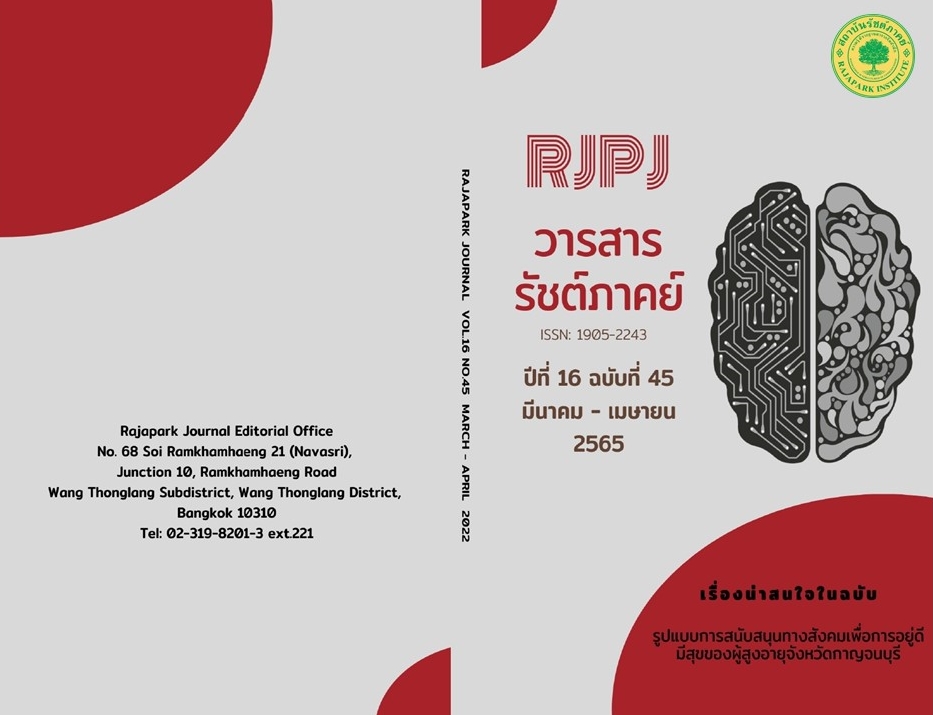Risk Management Maturity Model for Public Higher Education Institution
Main Article Content
Abstract
This quantitative research is aimed to analyze contents of the risk management process and construct risk management maturity model in Public Higher Education Institutes of the Office of the Higher Education Commission (OHEC). There were 385 sample sizes, which consisted of the administrators and the academic instructors. The multi-stage sampling was used to select 30 public higher institutes. The data were collected by using questionnaire. Data were analyzed by exploratory factor analysis. The results showed that the 75 variables can be divided into five groups with an Eigen value >1.00, which explained the variance of 75 variables for 66.81%. The maturity of risk management was divided into five levels, as follows: (1) natured; (2) established; (3) organized; (4) managed; and (5) integrated.
Article Details

This work is licensed under a Creative Commons Attribution-NonCommercial-NoDerivatives 4.0 International License.
Views and opinions appearing in the Journal it is the responsibility of the author of the article, and does not constitute the view and responsibility of the editorial team.
References
AON. (2010). Global Enterprise Risk Management Survey 2010. Retrieved June 13, 2020, from http://wrc.rims.org/HigherLogic/System/DownloadDocumentFile.ashx?DocumentFileKey=b5ed120b-3662-4293-ba93-03d2a72bfe7f
Chapman, J. R. (2011). Simple Tools and Techniques for Enterprise Risk Management (2nd ed.). Retrieved June 13, 2020, from http://www.insurance-institute.ru/library/zothers /chapman.pdf
Christensen, C.M., Horn, M.B., Caldera, L., & Soares, L. (2011). Disrupting College: How Disruptive Innovation Can Deliver Quality and Affordability to Postsecondary Education. Retrieved June 13, 2020, from https://www.semanticscholar.org/paper/Disrupting-College%3A-How-Disruptive-Innovation-Can-Christensen-Horn/e596dab7fdd850b9bc296ee396aa2f14acee8a1c #paper-header
Curkovic, S., Scannell, T., Wagner, B. J., & Vitek, M. J. (2013). A Longitudinal Study of Supply Chain Risk Management Relative to COSO’s Enterprise Risk Management Framework. Modern Management Science & Engineering, 1(1), 13-36.
Ekakul, T. (2000). Research Methods in Behavioral Sciences and Social Sciences. Ubon Ratchathani: Ubon Ratchathani Rajabhat Institute.
Ghazal, T., Soomro, T. R., & Shaalan, K. (2013). Integration of Project Management Maturity (PMM) based on Capability Maturity Model Integration (CMMI). European Journal of Scientific Research, 99(3), 418–428.
Hoyt, R., & Liebenberg, A. (2011). The Value of Enterprise Risk Management. Journal of Risk and Insurance, 78, 795-822.
Kaiyawan, Y. (2013). Multivariate Statistical Analysis for Research. Bangkok: Office of Academic Resources Chulalongkorn University.
Karunaratne, A.H.G.K. (2018). The Impact of the Adoption of Enterprise Risk Management on the Industrial Financial Performance: Evidence from Sri Lanka. International Journal of Research in Business and Social Science, 6(6), 9-20. DOI:10.20525/ijrbs.v6i6.815
Lappanopakorn, K., Jadesadalug, V., & Sansook, J. (2017). Developing Model of Risk Management Capabilities Toward Organizational Performance of Higher Education Institutions in Thailand. Dusit Thani College Journal, 11(3), 185-201.
Lundquist, A. E. (2015). Enterprise Risk Management (ERM) at U.S. Colleges and Universities: Administration Processes Regarding the Adoption, Implementation, and Integration of ERM (Doctor of Philosophy). Western Michigan University.
Malaivongs, K. (2015). Capability Model for Teaching. Retrieved July 19, 2020, from https://he01.tci-thaijo.org/index.php/EAUHJSci/issue/view/3859
Ministry of Higher Education, Science, Research and Innovation. (2018). Higher Education Statistics: Academic Year 2018. Bangkok: Zeno Publishing & Packaging.
Nocco, B., & Stulz, R. (2006) Enterprise Risk Management: Theory and Practice. Journal of Applied Corporate Finance, 18, 8-20. http://dx.doi.org/10.1111/j.1745-6622.2006.00106.x
Office of the Higher Education Commission. (2007). The Framework of the 15-year Long-Term Higher Education Plan, No. 2 (2008-2022). Bangkok: Office of the Higher Education Commission.
Oliva, F. L. (2016). A Maturity Model for Enterprise Risk Management. International Journal of Production Economics, Elsevier, 173, 66-79.
Proença, D., Estevens, J., Vieira, R., & Borbinha, J. (2017). Risk Management: A Maturity Model Based on ISO 31000. In Conference: 2017 IEEE 19th Conference on Business Informatics (CBI). DOI:10.1109/CBI.2017.40
Puncreobutr, V. (2019). Disruption in Thailand’ s Higher Education. APHEIT Journal, 25(1), 94-113.
Risk and Insurance Management Society. (2006). RIMS Risk Maturity Model (RMM) Enterprise Risk Management: Executive Summary. Retrieved June 13, 2020, from https://www.logicmanager.com/pdf/rims_rmm_executive_summary.pdf
Spikin, I. J. C. (2013). Developing a Risk Management Maturity Model: A Comprehensive Risk Maturity Model for Dutch Municipalities(Doctoral Dissertation). University of Twente.
The Committee of Sponsoring Organizations of the Treadway Commission [COSO]. (2017). Enterprise Risk Management - Integrating with Strategy and Performance,
Executive Summary. Retrieved June 13, 2020, from https://www.coso.org/Documents/2017-COSO-ERM-Integrating-with-Strategy-and-Performance-Executive-Summary.pdf
Wibowo, A., & Taufix, J. (2017). Developing a Self-assessment Model of Risk Management Maturity for Client Organizations of Public Construction Projects: Indonesia context. Science Direct, 171, 274-281.
Wirachai, N. (1999). LISREL Model: Statistical for Research (3rd ed.). Bangkok: Office of Academic Resources Chulalongkorn University.
Wiphatkrut, S. (2014). A Risk Management Model of Rajabhat Universities in Thailand. Journal of Interdisciplinary Research: Graduate Studies, 3(1), 45-67.


